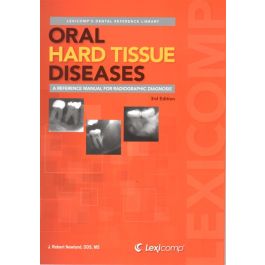Clinical Problem Solving in Orthodontics and Paediatric Dentistry Text and Evolve eBooks Package, 2nd Edition
by Declan Millett, Richard Welbury-
Soft Cover
KWD25.400
Review I personally like the approach of clinical-case based textbooks and find them much easier to learn from as the information is presented in a realistic situation. This book is very easy-to-read, its small brief sections of introduction, medical history, and investigations makes for easy, logical reading. The way the text asks and then answers a question is for me an excellent way to learn as it simulates what clinical staff may ask the student in this situation. The mind maps, I think, are also a particularly good feature of the book and unique in my experience. Most people choose to make things like this when they revise anyway so its handy to have the information required all linked together already. This book is suitable for undergraduate students as it is useful book for general revision (patients invariably will fall into one of the categories covered), viva exams and unseen 'finals cases' - many students find this type of book (and especially Clinical Problem Solving by Odell) particularly useful as the theories and methods can be applied to a real life case. The book may also be relevant inexperienced clinicians as a reference text. This is a book I would have never bothered looking at in a bookstore, proving the rule that you should never judge a book by its cover; however, after reading it for this review I can say that is has made orthodontics infinitely more appealing. Orthodontics is a subject so baffling that I wouldn't learn it unless I had to, but here the cases are worked through methodically and logically. I will certainly be recommending this text to other students. Chris Rutter 5th Year Dental Student, Birmingham This book should give almost all graduates a good grounding in these important areas! Mr Ray Reed, Consultant Orthodontic Surgeon, North Hampshire Hospital, Basingstoke, UK The book is relevant to curricular, certainly from the undergraduate and postgraduate paediatric dentistry perspective.. all the paediatric dentistry and combined clinical problems are ones that our undergraduates are expected to have knowledge and understanding of, as well as (we hope) to have encountered them either through clinical 'hands-on', observational or simulated (seminar) experience. The philosophy of the book is highly appropriate. The holistic paedodontic/orthodontic approach to managing child patients is key and well illustrated in the problems used in the book. The options and justifications for treatment are the main 'chapter outcomes' with thorough discussion of their advantages and disadvantages given. This is an important learning feature for the undergraduate as one of their many roles in general practice will be to be able to explain these treatment options to their patients as part of a process of referral for specialist care. The content of the mind maps helps to ensure inclusiveness and inter-disciplinary revision when students are using them to consolidate their knowledge and understanding. Dr Anne Maguire, School of Dental Sciences, Newcastle upon Tyne, UK Description: This is a second edition of a hugely successful practical resource in orthodontics and paediatric dentistry - ideal for undergraduate dental students and post-graduates preparing for the MJDF and similar exams. • Focuses on clinical problem-solving in orthodonticss and paediatric dentistry - two closely-related topics that are usually separated into different volumes. • • Provides practical help with treatment planning, guiding the reader through the process of safe and effective decision-making. • • Provides two different approaches to the clinical cases - some topics include scenarios with questions and answers; others include differential diagnosis with a focus on how to plan and manage treatment effectively. • • Uses ‘key-point" Evidence-Based’ boxes systematically to emphasise core knowledge for assessment and provide a rationale for treatment approaches. • • Contains valuable ‘mind-maps’, which helps the reader consolidate information prior to exams. • Includes orthodontic sections on severe crowding, additional canine problems, bilateral crossbite covering the use of temporary anchorage devices, incisor root resorbtion from an impacted maxillary canine, cone beam CT, tooth-size discrepancy assessment, transposition, RME, SARPE and self-ligating brackets • Includes paedriatric dentistry sections on the use of CPP-ACP, indirect pulp caps, caries diagnosis systems, minimally invasive techniques, and the importance of caries risk assessment and appropriate fluoride prescription, and mechanisms for how flouride works . Includes orthodontic sections on severe crowding, additional canine problems, bilateral crossbite covering the use of temporary anchorage devices, incisor root resorbtion from an impacted maxillary canine, cone beam CT, tooth-size discrepancy assessment, transposition, RME, SARPE and self-ligating brackets . Includes paedriatric dentistry sections on the use of CPP-ACP, indirect pulp caps, caries diagnosis systems, minimally invasive techniques, and the importance of caries risk assessment and appropriate fluoride prescription, and mechanisms for how flouride works.









